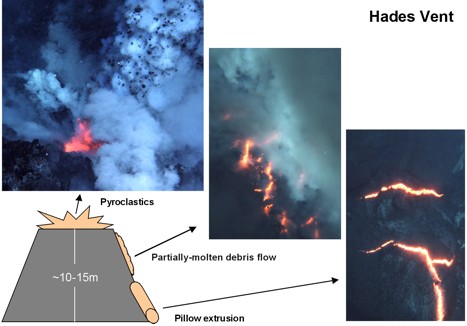Rubin
Timing, magnitude and impacts of recent eruptions in the NE Lau Basin: preliminary results of an event response cruise in May 2009
K. Rubin¹*, J. Resing², B. Embley³ & the NELRC science team
Corresponding author: krubin@hawaii.edu
¹Department of Geology and Geophysics, University of Hawaii, Honolulu, HI, 96822
²University of Washington, JISAO/PMEL 7600 Sand Point Way NE Seattle, WA 98115
³NOAA/PMEL, 2115 SE O.S.U. Drive, Newport, OR 97365
Abstract:
A short interdisciplinary expedition on the R/V Thompson was mounted in April 2009 (Resing and Embley, co-chiefs) to investigate suspected volcanic eruptions in the NE Lau basin, in response to multiple chemical and physical eruption indicators observed in the water column during a regional, Nov. 2008 NOAA-PMEL survey cruise. The NSF-NOAA funded-eruption-response effort used the Jason2 ROV and other research tools to survey and observe eruption-related phenomena at W. Mata volcano and the Northeast Lau Spreading Center (NELSC). W. Mata volcano was found to be erupting gas-rich magmas from multiple vents near its summit (1200m bsl), producing both pyroclastic deposits and pillow lavas. These observations provide important new insights into deep submarine eruption processes (e.g., see Fig. 1.). Much of the rest of the W. Mata summit region was covered in very young-appearing lavas and pyroclastics, some hosting diffuse flow hydrothermal venting sites colonized by a range of microbial and macro fauna. At the other study site, a very fresh, but now inactive lava sheet (the “Puipui flow”) was found along ~1.6 km of the NELSC crest (~1600 m bsl). There was no evidence of diffuse flow venting or faunal colonization on these new flows and no evidence for intense hydrothermal activity along this segment of the ridge crest. The Puipui eruption flowed around a previously known, well colonized low temperature hydrothermal site. Twenty one of 52 volcanic rocks collected on 7 Jason2 deployments at these sites are believed to be from very young eruption deposits, including one sample taken red hot from an actively advancing pillow tube. Investigations are underway to determine the aerial extent, composition, and ultra-high resolution ²¹⁰Po radiometric ages (t½ = 138 days) of these young deposits to constrain the duration and magnitude of recent eruptions at both sites. This information will allow us to assess the impacts of volcanic eruptions on hydrothermal systems and associated fauna in this tectonic setting. A comparison and contrast of the Lau basin cases to system responses at other documented recent eruption sites on the East Pacific Rise and Juan de Fuca Ridge (where volcanic activity appears to be predominantly effusive), and at NW Rota volcano, Marianas, (where volcanic activity appears to be predominantly pyroclastic) should illuminate important controls and linkages on processes that occur in eruption-perturbed ecosystems.
Keywords:
Submarine eruptions, Lau Basin, ²¹⁰Po dating, Time Critical Studies.
Contributions to Integration and Synthesis:
Although the project is in its early stages, it was conceived as a mantle-to-microbe experiment during which observations were made of each pertinent aspect of the system from the sea bed to water column. The geology/geochronology component of this project is intended to provide information on the size and duration of volcanic events at the study sites. Contrasting these with what is known about the small number of other known deep submarine eruptions sites, and how these eruptions impacted hydrothermal and biological aspects of these volcanoes, will undoubtedly shed light on system linkages and feedbacks in submarine volcanic-hosted ecosystems.
Figures:
Figure 1. Schematic representation of concurrent eruptive activity at one of multiple active vent edifices at W. Mata Volcano. Frequent pyroclastic expositions occurred at the summits of irregular mounds of volcanic material at the vent, occasionally followed by partial collapse of the edifice top, producing glowing hot flows of agglutinated debris. Meanwhile, active pillow extrusion was occurring at the base of the mounds. Rubin_fig1.jpg

